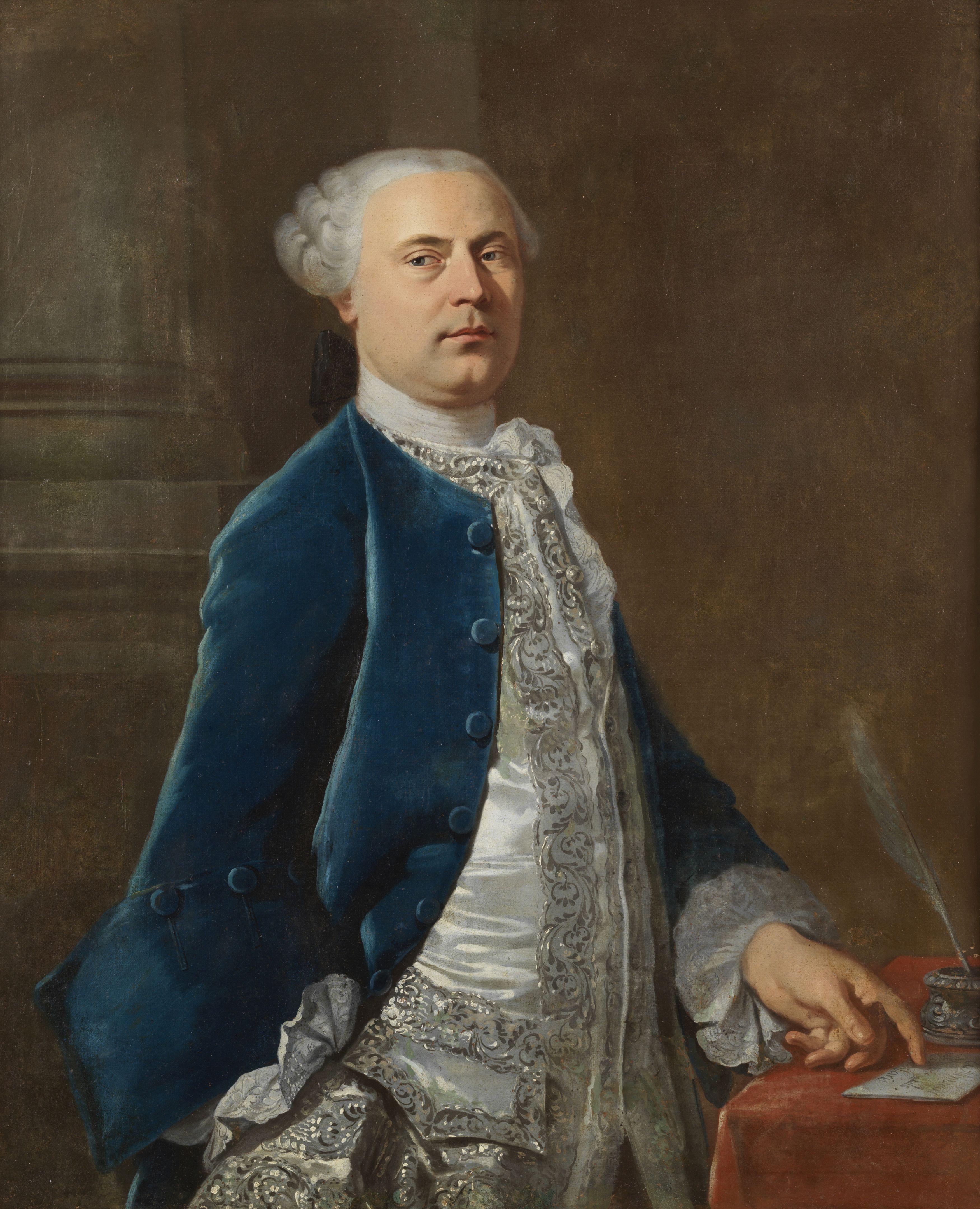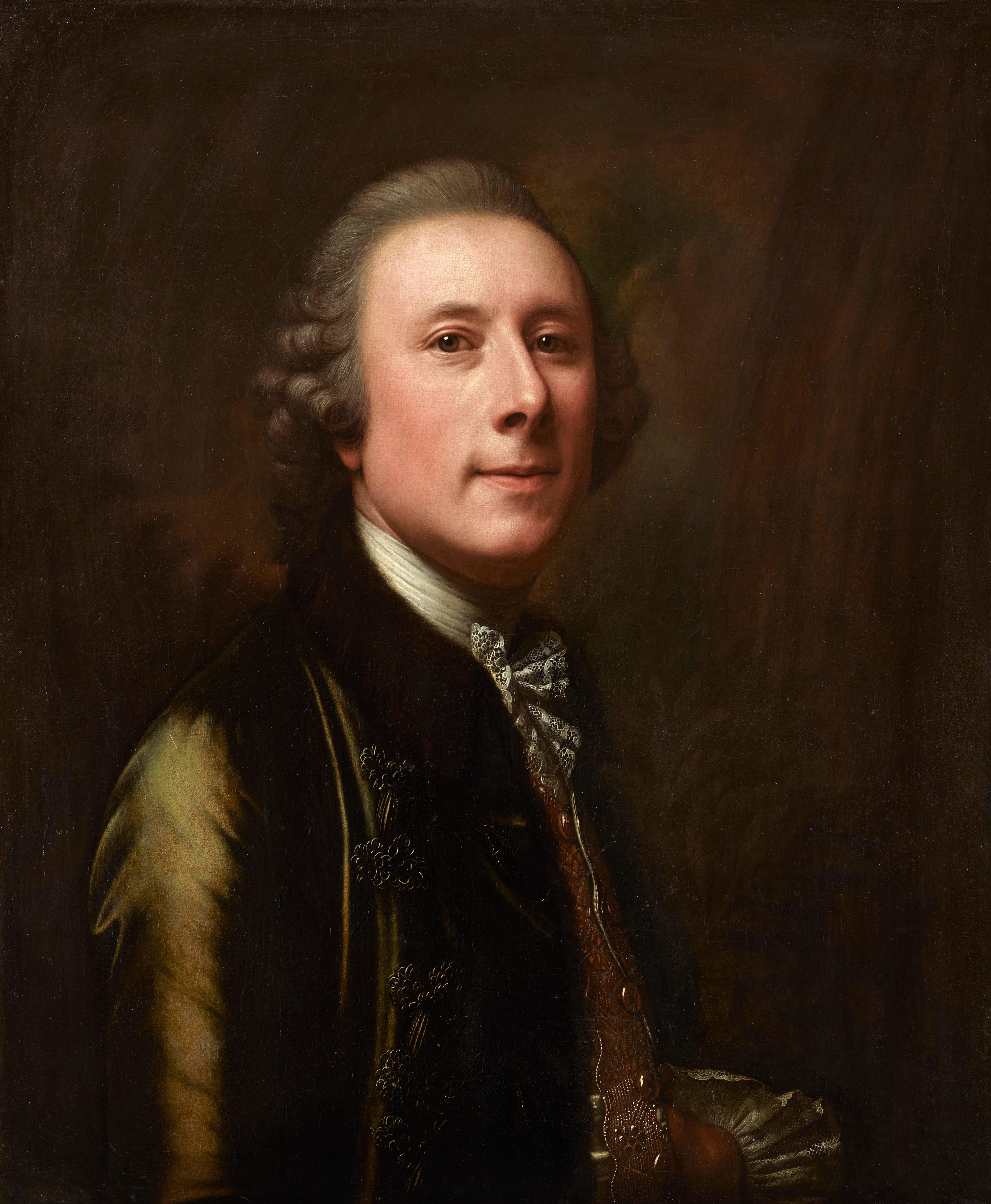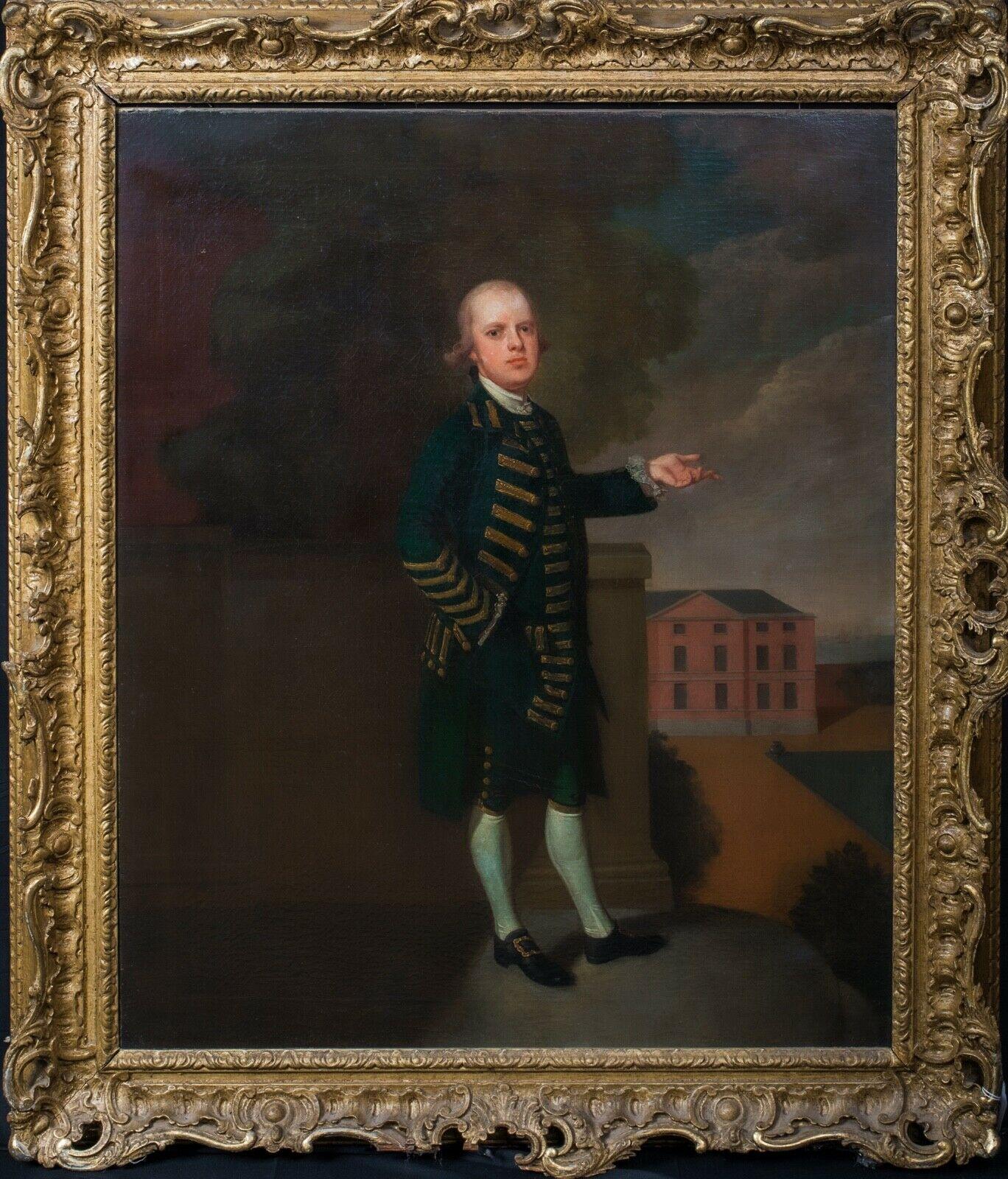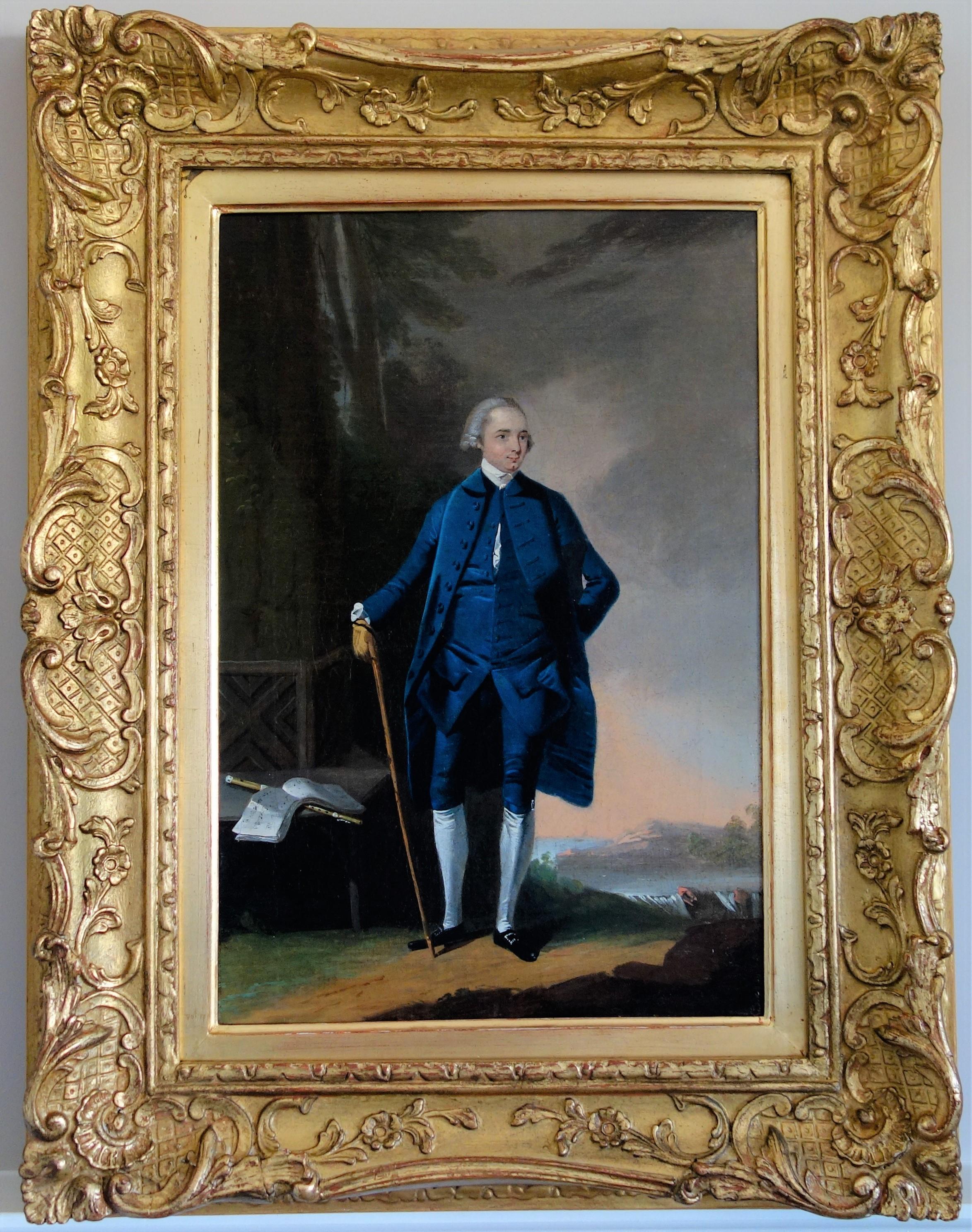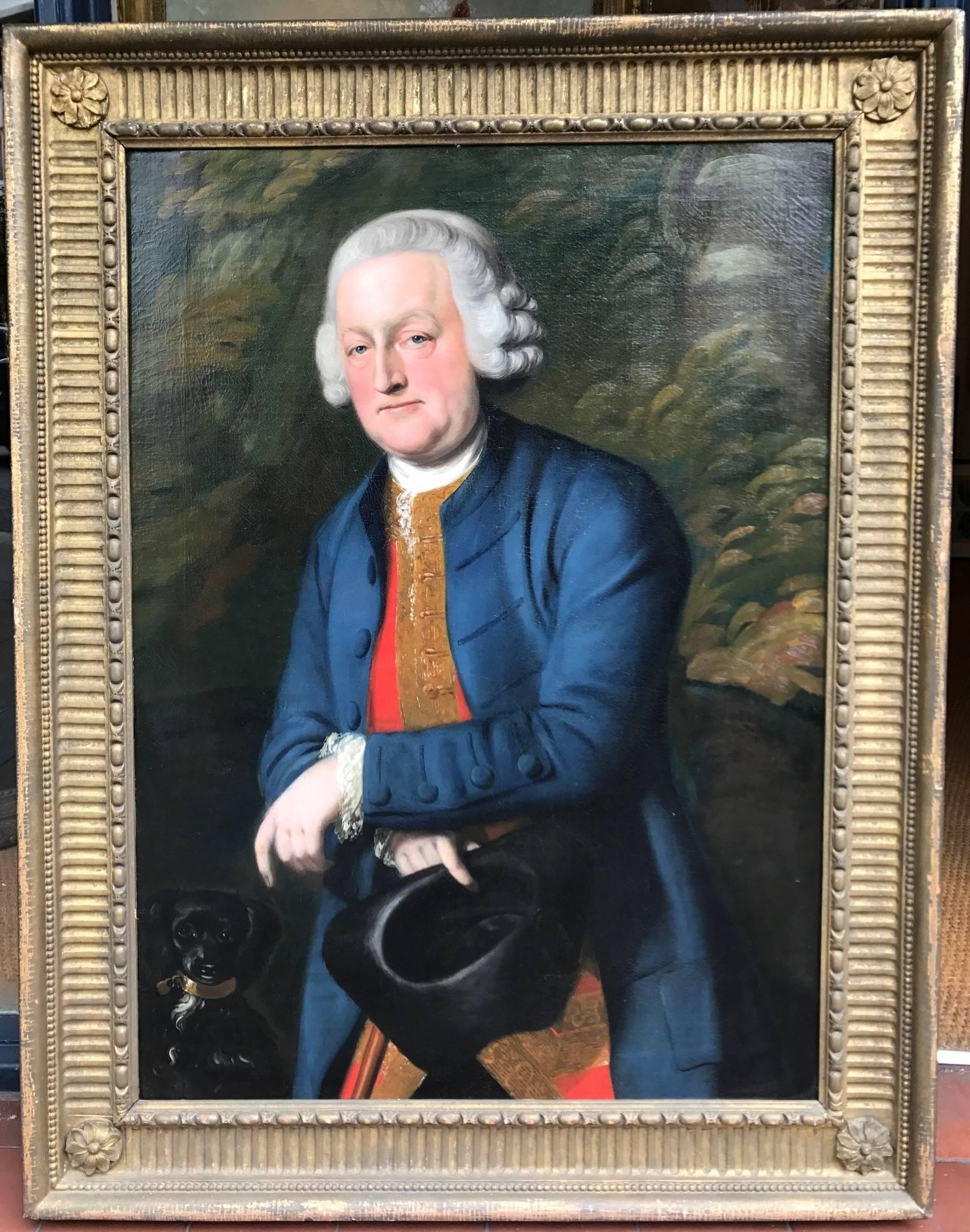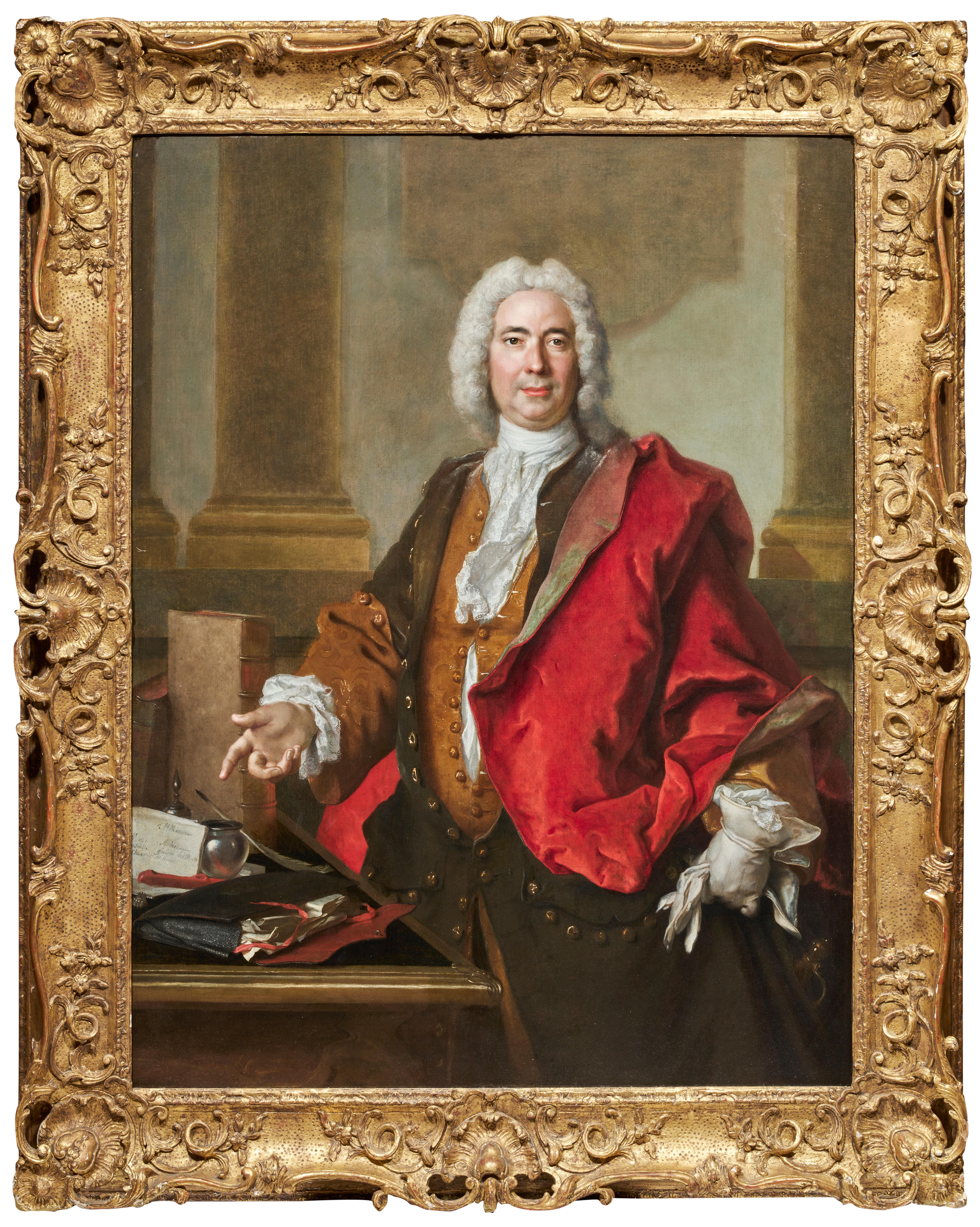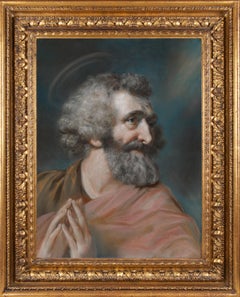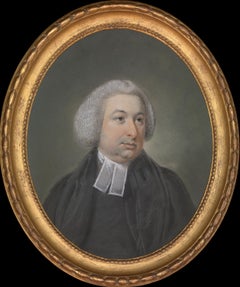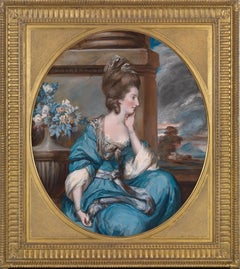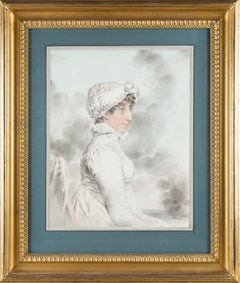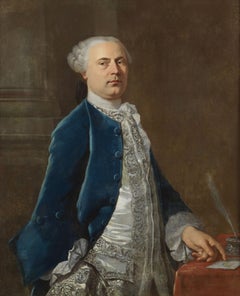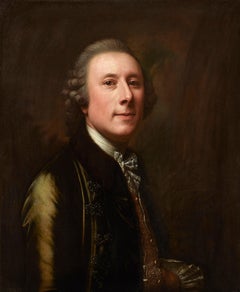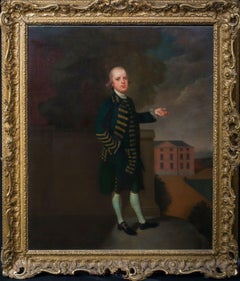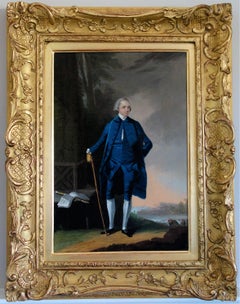Items Similar to 18th century portrait of the painter Nathaniel Dance
Want more images or videos?
Request additional images or videos from the seller
1 of 5
Johan Zoffany18th century portrait of the painter Nathaniel Dance1770s
1770s
$67,137.84
£48,000
€57,322.49
CA$91,843.22
A$102,775.14
CHF 53,664.35
MX$1,263,513.37
NOK 677,037.63
SEK 637,089.07
DKK 427,669.71
Shipping
Retrieving quote...The 1stDibs Promise:
Authenticity Guarantee,
Money-Back Guarantee,
24-Hour Cancellation
About the Item
Collections:
Robert Gallon (1845-1925);
Private Collection, UK.
Oil on canvas laid down on panel
Framed dimensions: 11.5 x 10 inches
This highly engaging, previously unpublished portrait by Johan Zoffany represents an important addition to his oeuvre. Exceptionally finely painted, the portrait study is unfinished and thus provides us with some information about Zoffany’s working method. Zoffany’s wide ranging training and career encompassing Germany, England, Grand Tour Italy and India has recently received much scholarly attention: a biography appeared in 2009 followed by a comprehensive survey of his works by Mary Webster in 2011, the same year in which a major exhibition of over a hundred of his works was held at the Yale Center for British Art and Royal Academy of Arts in London. This attention has prompted a reassessment of Zoffany’s role as one of the most versatile and acute observers of British society, but also as one of the finest portraitists of the eighteenth-century.
The sitter of the present portrait has recently been identified as the painter Nathaniel Dance. Given the immediacy, confidence and most importantly scale of the likeness, it seemed likely to be a study for one of Zoffany’s conversation pieces rather than a full-size portrait. Stylistically it dates from the 1770s, the decade Zoffany was at the height of his powers, when he executed several of his most enduring compositions including Portraits of the Academicians of the Royal Academy and Tribuna of the Uffizi. In preparation for the first of these monumental canvases, commissioned by King George III to commemorate the foundation of the Royal Academy of Arts in London, Zoffany made a series of small-scale oil studies, at least one of which survives. In February 1772 Zoffany went to Bath to paint Thomas Gainsborough for inclusion in the conversation piece, the resulting portrait study remained with the sitter’s family until it was presented to the National Gallery in 1896 and subsequently transferred to the Tate in 1955. Like the present picture, the portrait of Gainsborough is fluidly painted and left unfinished, the sitter is seen animatedly looking to the right and would have served as a model for inserting the head into the finished conversation piece. Along with Gainsborough – who seems likely to have refused inclusion on the grounds of his growing animosity towards the hanging committee - the brothers George and Nathanial Dance were also omitted from the group. The painting is first recorded in the collection of the nineteenth-century landscape painter Robert Gallon.
For Zoffany friendship was frequently expressed through portraiture and the intimate scale and unfinished nature of the present work reinforces the idea that it was the study of someone he knew well. We know Zoffany was in the habit of painting oil studies during theatrical performances, a fact confirmed by the rare survival of two studies of David Garrick as Abel Drugger in The Alchymist at the Ashmolean. The partially painted canvas reveals Zoffany’s characteristic off-white ground, which is visible at the bottom of the canvas, beneath the sitter’s white stock. Fluid lines of light brown paint are also clearly visible and these are characteristic of Zoffany’s method for blocking in the features and poses of his sitters. The head itself is bought up to an extraordinarily high level of finish, the features are handled with characteristic delicacy, adding unblended passages of highlight to impart a vitality to the expression. The portrait, which was cut-down at some point and laid-down on a mahogany panel, survives in outstanding condition and directly demonstrates the vivacity and incisiveness with which Zoffany drew with the brush.
- Creator:Johan Zoffany (1733 - 1810, German)
- Creation Year:1770s
- Dimensions:Height: 6 in (15.24 cm)Width: 4.5 in (11.43 cm)
- Medium:
- Movement & Style:
- Period:
- Condition:Painting preserved in excellent condition, housed in a giltwood frame.
- Gallery Location:London, GB
- Reference Number:1stDibs: LU150727730712
About the Seller
5.0
Recognized Seller
These prestigious sellers are industry leaders and represent the highest echelon for item quality and design.
1stDibs seller since 2021
- ShippingRetrieving quote...Shipping from: London, United Kingdom
- Return Policy
Authenticity Guarantee
In the unlikely event there’s an issue with an item’s authenticity, contact us within 1 year for a full refund. DetailsMoney-Back Guarantee
If your item is not as described, is damaged in transit, or does not arrive, contact us within 7 days for a full refund. Details24-Hour Cancellation
You have a 24-hour grace period in which to reconsider your purchase, with no questions asked.Vetted Professional Sellers
Our world-class sellers must adhere to strict standards for service and quality, maintaining the integrity of our listings.Price-Match Guarantee
If you find that a seller listed the same item for a lower price elsewhere, we’ll match it.Trusted Global Delivery
Our best-in-class carrier network provides specialized shipping options worldwide, including custom delivery.More From This Seller
View All18th century portrait of the Royal Academy model George White
By John Russell
Located in London, GB
Collections:
Russell sale, Christie’s, 14 February, 1807: ‘John Russell, Esq., R.A. deceased, crayon painter to His Majesty, the Prince of Wales, and Duke of York; and brought from his late Dwelling in Newman Street’, lot 92, ‘St Peter’, bt. Thompson (£1.13s);
Anonymous sale; Sotheby's, London, 25th September 1980, lot 113;
Private collection, UK, 2016.
Literature:
Martin Postle, 'Patriarchs, prophets and paviours: Reynolds's images of old age', The Burlington Magazine, vol. cxxx, no. 1027, October 1988, pp. 739-40, fig. 9;
Martin Postle, Sir Joshua Reynolds: The Subject Pictures, Cambridge, 1995, p.136, repr.;
Neil Jeffares, Dictionary of pastellists before 1800, online edition, J.64.2928.
Signed and dated: J Russell/ fecit 1772 (lower right)
Framed dimensions: 25 x 31 inches
John Russell was admitted to the Royal Academy in March 1770, at the same time as Daniel Gardner. The nascent Academy Schools were still establishing their teaching structures, but central to the syllabus were the twin components of drawing after the antique and from life models. By 1772 Russell had already been awarded a silver medal and progressed to the life academy, where he produced this remarkable pastel study of George White. White was the most famous model employed by the Royal Academy and prominent artists in the second half of the eighteenth century. A paviour – or street mender –by profession White had been discovered by Joshua Reynolds, who in turn introduced him to the Academy. Russell’s striking head study demonstrates his abilities as a portraitist and pastellist, at the same time showing his interest in the Academy’s preoccupation with promoting history painting.
George White was one of the most celebrated models in eighteenth-century London. According to the painter Joseph Moser:
'Old George…owed the ease in which he passed his latter days, in a great measure to Sir Joshua Reynolds, who found him exerting himself in the laborious employment of thumping down stones in the street; and observing not only the grand and majestic traits of his countenance, but the dignity of his muscular figure, took him out of a situation to which his strength was by no means equal, clothed, fed, and had him, first as a model in his own painting room, then introduced him as a subject for the students of the Royal Academy.'
As Martin Postle has pointed out, whilst characterful studies of old men posed as biblical figures, prophets or saints by Continental old masters were readily available on the art market – Reynolds himself had copied a head of Joab by Federico Bencovich in the collection of his friend and patron, Lord Palmerston - finding a model in Britain from whom to execute a painting was more difficult.
White therefore offered a rare opportunity for artists to combine portraiture and history painting, by painting a model in the guise of an historical or literary character. In 1771 Reynolds showed at the Royal Academy a picture of White entitled Resignation. It was engraved in 1772 and accompanied by a stanza from Oliver Goldsmith’s Deserted Village, implying a literary context to what is essentially a portrait. In his annotated Royal Academy catalogue, Horace Walpole noted: ‘This was an old beggar, who had so fine a head that Sir Joshua chose him for the father in his picture from Dante, and painted him several times, as did others in imitation of Reynolds. There were even cameos and busts of him.’ White sat to, amongst others Johan Zoffany, John Sanders, Nathaniel Hone and the sculptor John Bacon...
Category
18th Century Old Masters Portrait Drawings and Watercolors
Materials
Pastel
Eighteenth-century Irish portrait of the Rev. Henry Dabzac
By Hugh Douglas Hamilton
Located in London, GB
Pastel on paper, oval
9 x 7 ¼ inches; 230 x 185 mm
Inscribed on the verso:
‘The Revd Henry Dabzac D.D./ late Senior Fellow of/ Trinity College Dublin/ ever to be lamented by all that knew/ Him. Extensive learning, zeal, gently tempered/ by a spirit of charity & above all, a strong/ faith & a piety deservedly gained/ the character of a great and good man./ This exceptional man died 12th May 1790/ This picture was his give to Jane [Mary] Crofton, his sincerely [missing] sister.’
Collections:
Rev. Dr Henry Dabzac gift to his sister, Jane Crofton (d.1797);
Sir Hugh Crofton (1763-1834);
By descent to 1990;
Private collection, Dorset to 2020.
Literature:
Robert Staveley, Traces of Past and Present, Dublin, 1895, p.74;
Neil Jeffares, Dictionary of Pastellists Before 1800, online edition, no.J3751247
This characteristic pastel portrait by Hugh Douglas Hamilton was made early in his career; it depicts precisely the kind of education, well-connected Irish sitter who fuelled his success. The Reverend Henry Dabzac was from a distinguished Huguenot family, a celebrated academic historian, Dabzac received the Donegall lectureship in 1764 and from 1785 was Librarian and Senior Fellow of Trinity College, Dublin. According to his earliest biographer, Hamilton was the son of a peruke-maker based in Crow Street, Dublin. As Anne Hodge has pointed out, this places Hamilton’s father at the heart of the city: Crow street was a narrow thoroughfare formed part of the busy warren of streets bordered by the old Houses of Parliament and Trinity College at one end, and by Dublin Castle at the other. It is perhaps telling that in this early portrait, Hamilton shows Dabzac in a splendid powdered wig and his clerical bands. In 1754 Hamilton was apprenticed to James Mannin, a ‘pattern drawer’ who two years later was appointed master of the school of ornament at the Dublin Society’s drawing school, run by Robert West. Here Hamilton took the first prize in the 1755 competition, winning a premium of £1/16/. Hamilton developed a popular and profitable method of making pastel likenesses of sitters in a distinctive oval format. Hamilton developed a technique of using a sharpened pastel to hatch shaded areas of the features and, in the case of this portrait of Dabzac, the white powdered wig, which is drawn with particular care. In 1764 Hamilton moved to London where this small, oval pastels proved...
Category
18th Century Old Masters Portrait Drawings and Watercolors
Materials
Pastel
Portraits of the Hon. Mary Shuttleworth and Anna Maria, 9th Baroness Forrester
By Daniel Gardner
Located in London, GB
THE HON. MARY SHUTTLEWORTH, NÉE COCKBURN (D. 1777)
and her sister
ANNA MARIA, 9TH BARONESS FORRESTER (D. 1808)
Pastel and gouache on paper laid on canvas, on their original backb...
Category
18th Century Old Masters Portrait Drawings and Watercolors
Materials
Pastel, Gouache
Regency portrait drawing of Arabella Graham-Clarke
By John Downman
Located in London, GB
Collections:
The sitter, and by descent;
Christie's, 19th March 1928, lot 6;
Private collection to 2019
Literature:
G.C. Williamson, John Downman, A.R.A., his Life and Works, Lon...
Category
Early 19th Century Old Masters Portrait Drawings and Watercolors
Materials
Pencil, Watercolor
Regency portrait drawing of Lady Nugent
By John Downman
Located in London, GB
Collections:
With Ellis Smith, London;
Private collection, to 2015.
Literature:
G.C. Williamson, John Downman A.R.A., his Life and Works,
p. lviii no...
Category
19th Century Old Masters Portrait Drawings and Watercolors
Materials
Pencil, Watercolor
18th century portrait drawing of the Rev. William Atkinson
By George Romney
Located in London, GB
Collections:
Henry Scipio Reitlinger (1882-1950);
Private collection, UK to 2019
Framed dimensions: 14.50 x 15.38 inches
This drawing is one of only two known portrait drawings by Romney (as opposed to preliminary studies for portraits) and is dated by Alex Kidson as being executed no later than 1769. It is likely that the present drawing was originally part of a sketchbook, now largely dismembered (Abbot Hall Art Gallery, Kendal), which Kidson notes, contained some of Romney’s most beautiful early drawings. This drawing, and a second sheet formerly with Andrew Wyld, have been identifying as depicting the Rev. William Atkinson...
Category
18th Century Old Masters Portrait Drawings and Watercolors
Materials
Pencil
You May Also Like
18th Century Portrait of a Gentleman French School Man Oil on Canvas Blue White
Located in Sanremo, IT
Painting, oil on canvas, measuring 92 x 75 cm without frame and 102 x 87 cm with frame depicting a nobleman of the French school of the first half of the 18th century.
In its formal...
Category
Early 18th Century French School Portrait Paintings
Materials
Canvas, Oil
Portrait of a Gentleman, 18th Century Oil Painting
By Anton von Maron
Located in London, GB
Oil on canvas
Image size: 20 x 24 inches (51 x 61 cm)
Period gilt frame
This is a half-length portrait of a gentleman wearing a emerald coat and intricately designed waistcoat, dat...
Category
1760s Portrait Paintings
Materials
Canvas, Oil
Portrait Of A Gentleman & His Estate, Attributed to Arthur Devis, 18th Century
By Arthur Devis
Located in Blackwater, GB
Portrait Of A Gentleman & His Estate, 18th Century
attributed to Arthur DEVIS (1712-1787)
One of a matching pair - the other is believed to be the brother
Large 18th century Eng...
Category
18th Century English School Portrait Paintings
Materials
Canvas, Oil
18th century portrait of the German Flautist and composer Johann Joachim Quantz
By Arthur Devis
Located in Bath, Somerset
Portrait of Johann Quantz (1697-1773), flautist and composer, wearing a blue velvet coat, waistcoat and breeches, standing in a garden landscape with ...
Category
18th Century English School Portrait Paintings
Materials
Canvas, Oil
$15,106 Sale Price
20% Off
18th Century Oil Painting Portrait of Phillip, 6th Viscount Wenman.
By Nathaniel Dance-Holland
Located in London, GB
Sir Nathaniel Dance-Holland (1750-1811) was an English portrait painter and one of the founding members of the Royal Academy in 1768. Justly celebrated in his lifetime he won several...
Category
Late 18th Century Old Masters Portrait Paintings
Materials
Oil
Portrait of Monsieur Aubert, a ceremonial portrait by Nicolas de Largillière
By Nicolas de Largillière
Located in PARIS, FR
Provenance :
Arnold S. Kirkeby (1901-1962)
Donated by Arnold S. Kirkeby to the Los Angeles County Museum of Art in 1955, where it remained until its sale at Sotheby's, New York on Ja...
Category
1720s Old Masters Portrait Paintings
Materials
Oil
More Ways To Browse
India Painting 18th Century
Old Antique Wood Picture Frames
18th Century George Iii Painting
Erte Kiss Of Fire
Erte Le Soleil
Erte Nocturne Serigraph
Erte Nocturne
Erte Starstruck
Erte Stranded
Erte The Globe
Erte Venus
Esther Wertheimer
Ethel Stein
Ethel Welch
Eugène Leliepvre On Sale
Eugene Leliepvre
Evelyn Ortiz
Ewa Juszkiewicz
